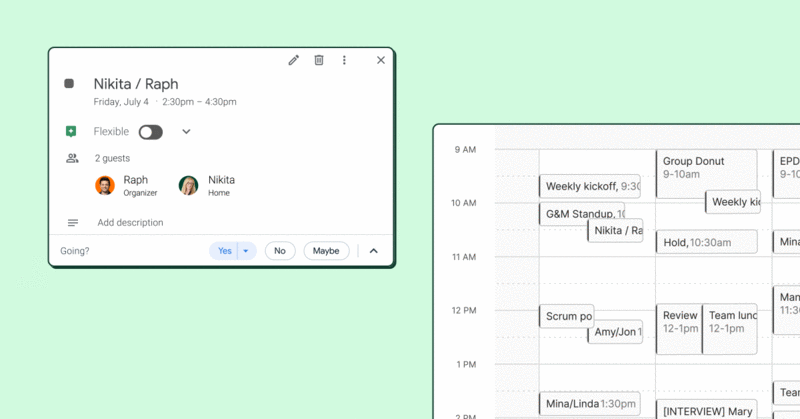It’s a scene that many of us are familiar with. The slow tempo of a ticking clock, the voice of whoever’s speaking fading in and out as you think about everything you’d rather be doing. (Kind of like when you try meditating the first time.)
The truth is, meetings can be a poor use of everyone’s time — unless they’re planned well. You’ve already heard the tip, “Don’t hold a meeting for something that could’ve been in an email.” However, there are so many more strategies to effective team meetings!
In this guide, we’ll break down everything you need to know to make team meetings more productive, engaging and, dare we say it, enjoyable for the whole team. You can adapt these tips to work for your weekly team sync meeting, retrospective, or whatever meeting format you like.
Warning: Productive meetings ahead!
The importance of effective team meetings
When done right, a team meeting offers short- and long-term payoffs.
Some perks include:
- Cutting down on email. Meetings get a bad rap for wasting time, but other alternatives like email can be just as inefficient, given delayed responses and the tediousness of typing. If you find yourself playing email ping-pong, ask yourself: How much time could I save if I were to communicate this during a staff meeting? When it comes to collaborative functions like decision-making and brainstorming, face-to-face meetings take the cake!
- Decluttering irrelevant tasks, goals, and processes. Team meetings are a fantastic time to separate the busywork from work that actually moves the needle. Over time, teams often pick up unnecessary tasks and minutiae. During meetings, clear those out like the expired ketchup in the back of your fridge. Just like the ketchup is taking up space in the refrigerator, those action items are hogging valuable team bandwidth.
- Boosting camaraderie and teamwork. According to Atlassian, the top contributor to happiness at work is feeling like you belong. With the distributed team more common these days, it’s easy for folks to forget they’re part of a team, which in turn, has an effect on employee engagement and happiness. Team meetings offer the time and space to foster that sense of belonging and go from disjointed to connected.
Check out this video from Anna, our Head of Community, about how to waste less time in meetings:
Preparing for a successful team meeting
1. Get clear on the “why.”
Before hitting "Send" on that invite for your next internal team meeting, make sure you know exactly why you’re gathering the team. Are you brainstorming new ideas, sharing information, taking part in some decision-making? Being able to articulate the meeting’s purpose communicates to invitees (and yourself!) that the meeting is worthy of everyone’s time.
2. Craft a game plan.
A well-thought-out agenda is like a roadmap for your meeting. Jot down the must-hit agenda items, allocate time for each, and decide who’s leading the discussion. When everyone knows what’s coming, there’s less chance for the meeting to go off the rails. Plus, it gives team members a chance to chew through the topics and gather their thoughts beforehand.
Pro tip: Steve Rogelberg, the author of The Surprising Science of Meetings: How You Can Lead Your Team to Peak Performance, suggests framing agenda items as questions instead of vague phrases like “discuss launch strategy” or “talk about budget.” This technique is like an on-switch for critical thinking, sharpening focus and guiding the conversation toward solutions!
3. Assign the A team.
Before the meeting kicks off, determine who needs to be there. Is your meeting leader ready to steer the conversation? Decide who will take notes and manage time, and make sure everyone knows their role ahead of time. This way, you’ll have the right voices at the table, ensuring a smooth flow and setting the stage for a productive meeting.
4. Pick the perfect time.
Finding time to meet with a busy or large group of people can be daunting, especially when you don’t have insight into every attendees’ preferences. That’s why we created Clockwise, an AI-powered calendar assistant that understands preferences and habits across entire teams and companies to suggest the best time for everyone.
Best practices during the meeting
1. Start on time
Kick things off promptly to respect everyone’s busy schedules. Starting on time sets a professional tone and keeps the energy up from the very start.
2. Review the agenda
Begin with a quick overview of the agenda. This helps everyone know what to expect and keeps discussions focused on the key topics.
3. Encourage participation
Create a welcoming environment where all team members feel comfortable sharing their insights. Use open-ended questions to draw out quieter voices — everyone has something valuable to contribute!
4. Stay on track
Keep discussions aligned with the agenda items. If conversations start to wander, gently guide them back on course to ensure a smooth and efficient meeting. We love the “parking lot” technique where you “park” an off-topic comment by jotting it down somewhere, saving it for another time.
5. Clarify next steps
As you wrap up each discussion, go over the key takeaways and assign action items. Make sure everyone’s clear on who’s doing what, and log those tasks in your project management tool to keep everything organized and moving smoothly.
Follow-up actions after the meeting
Once the meeting wraps up, it’s important to follow up with the team to keep the momentum going. Start by sharing the meeting minutes so everyone can refer back to key points and assigned tasks. Then, the team leader or project manager can check in afterward to confirm progress on the agreed-upon action items, or to see if any bottlenecks need to be addressed.
Tools for running effective team meetings
Clockwise
Want to get your next meeting on the calendar without the back-and-forth? Now you can with Clockwise. Clockwise is an AI-powered calendar assistant that builds better and more productive schedules — designed to alleviate the stress of calendar management for busy professionals.
Powered by automation and AI, Clockwise rapidly calculates the best time for meetings, tasks, and deep work — all based on your preferences. No more mind reading or trying to conjure time out of nowhere. Clockwise works across individuals, teams, and entire companies, and it gets smarter and more powerful as more people use it.
That’s intelligent calendaring.

Fellow
Modernize your meeting notes. Fellow is an AI meeting note-taker that takes care of the heavy lifting by recording, transcribing, and summarizing your team meetings in real-time. It automatically pinpoints action items, making it easy to follow up afterward. With meeting notes handled, meeting participants can focus on contributing to the conversation without distractions.
Fellow also helps you create collaborative meeting agendas with ease, offering over 500 templates to streamline your planning. Plus, with clear meeting minutes available after every session, staying organized and on top of tasks becomes effortless.
Pssst, steal our template for our weekly kickoff meetings!

Miro
Teams that thrive on visual collaboration will love this next tool, especially when they can’t meet in person. This AI-powered visual workspace enhances virtual meetings with interactive features like an online whiteboard, pen tool, and sticky notes. For meetings where creativity and visualization are key, Miro’s tools — like breakout frames, voting, and presentation mode — bring a dynamic touch without sacrificing the essentials like meeting notes and organization.
Check out a few of the templates you find on Miro below!

Tips for virtual team meetings
Enhance your virtual meetings with these bonus tips:
- If you’re screensharing, have your tabs and windows prepped and ready.
- Be consistent with your video conferencing platform. Prevent confusion by using the same tool (Zoom, Slack, Meet, etc.) regularly for your team meetings.
- Test tech ahead of time, including your internet connection, camera, and audio.
How to improve team meetings
A lot of the improvements in your team meetings will occur organically, especially as your team settles into a nice rhythm. For example, it might feel a little awkward for leaders to reroute the meeting when conversations go off on a tangent. But with practice they’ll become more comfortable doing this!
However, it’s also important to take initiative when it comes to improving your team meetings. The best way to do that? Through surveys and/or asking for feedback either online or in-person. Because while you can brainstorm by yourself, the truth is that the people sitting across from and next to you in that meeting have valuable insights. They can catch your blindspots and shed light on what’s working that you overlooked.
Here are some questions to gather priceless feedback and level up your team’s meetings now:
- Do you leave meetings feeling energized or worn-out?
- Are meetings too long or too short?
- Is there anything that we cover in our meetings that are better addressed outside of the particular meeting?
- Do we offer enough clarity during our meetings?
- Does the time of the meeting work for you?
- Do you feel like we could break the team down into smaller groups?
- How do you feel about our use of [Slack, Zoom, or whatever tools you may use to conduct your meetings]?
Remember, the meetings aren’t there to just serve the bottom line. They’re also meant to serve your people. Surveys support that mission. There are a number of ways to collect responses, from tools like Google Forms and SurveyMonkey, to 1:1 meetings, to email.
Going forward
Despite your past experiences with team meetings, we’re here to tell you it’s possible to go from mundane to masterful, pointless to productive. Together, let’s revitalize the way we look at our meetings. So, remember: put care into your team meeting agenda, leverage the right tools, and engage the entire team!

%20Large.jpeg)
.gif)
.png)
.jpg)


